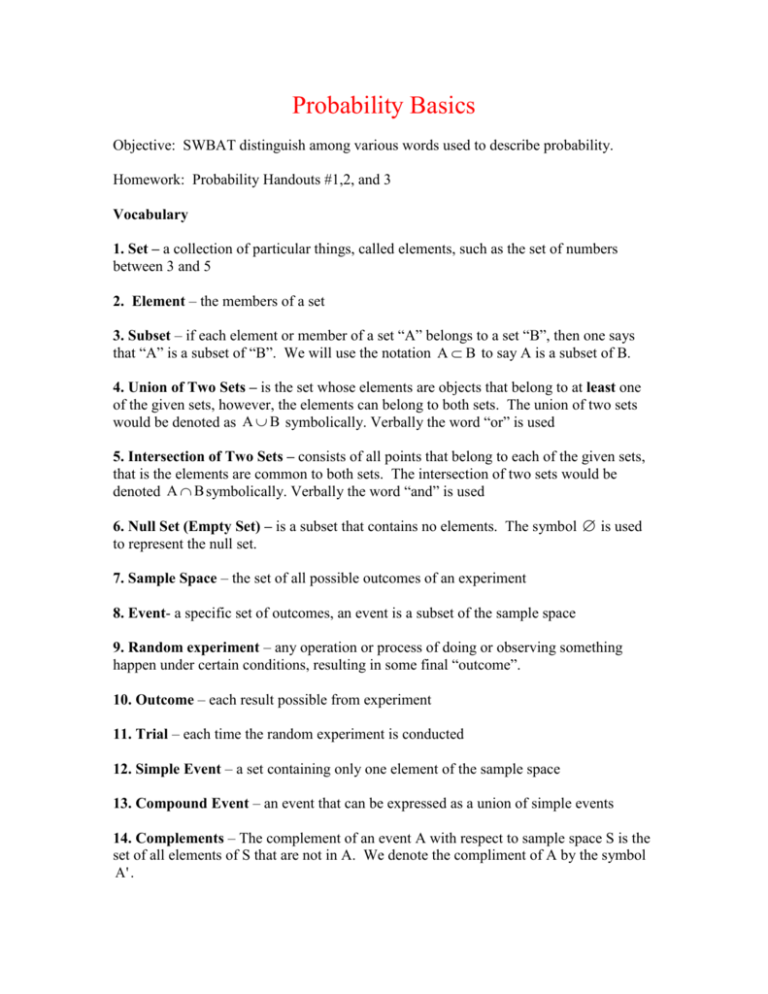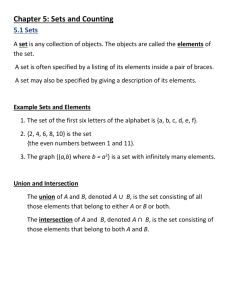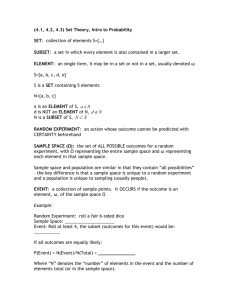Probability Lesson 1
advertisement

Probability Basics Objective: SWBAT distinguish among various words used to describe probability. Homework: Probability Handouts #1,2, and 3 Vocabulary 1. Set – a collection of particular things, called elements, such as the set of numbers between 3 and 5 2. Element – the members of a set 3. Subset – if each element or member of a set “A” belongs to a set “B”, then one says that “A” is a subset of “B”. We will use the notation A B to say A is a subset of B. 4. Union of Two Sets – is the set whose elements are objects that belong to at least one of the given sets, however, the elements can belong to both sets. The union of two sets would be denoted as A B symbolically. Verbally the word “or” is used 5. Intersection of Two Sets – consists of all points that belong to each of the given sets, that is the elements are common to both sets. The intersection of two sets would be denoted A B symbolically. Verbally the word “and” is used 6. Null Set (Empty Set) – is a subset that contains no elements. The symbol is used to represent the null set. 7. Sample Space – the set of all possible outcomes of an experiment 8. Event- a specific set of outcomes, an event is a subset of the sample space 9. Random experiment – any operation or process of doing or observing something happen under certain conditions, resulting in some final “outcome”. 10. Outcome – each result possible from experiment 11. Trial – each time the random experiment is conducted 12. Simple Event – a set containing only one element of the sample space 13. Compound Event – an event that can be expressed as a union of simple events 14. Complements – The complement of an event A with respect to sample space S is the set of all elements of S that are not in A. We denote the compliment of A by the symbol A' . 15. If two die are rolled the following vocabulary words would be applied accordingly Random Experiment – the act of rolling the dice. Trial – each time you rolled the dice. Outcome (simple event) – each way the dice could come up. Event – a set of outcomes – For example, “the total on two dice is 6” Sample space – the set of all outcomes of an experiment Now that we have a handle on some vocabulary, we can define probability a little better. If the outcomes of a random experiment are equally likely, then the probability that a particular event will occur is Verbally : Probability = Symbolically: P(E) = number of outcomes in the event number of outcomes in the sample space n(E) n(S) Where n(E) is the number of outcomes in the event E and n(S) is the number of outcomes in the sample space S. 16. Two dice are rolled, one white and one blue. Find the probability of each of these events. a. The total is 8. b. The total is at least 8. c. The total is less than 8. d. The total is at most 8. e. The total is5. f. The total is 2. g. The total is between 2 and 7, inclusive. h. The total is between, but does not include, 2 and 7. i. The total is between 2 and 12, inclusive. j. The total is 13. k. The numbers are 3 and 5. l. The blue die shows 4 and the white die shows 5. m. The blue die shows 3 or the white die shows 5. 1,1 2,1 3,1 4,1 5,1 6,1 1,2 2,2 3,2 4,2 5,2 6,2 1,3 2,3 3,3 4,3 5,3 6,3 1,4 2,4 3,4 4,4 5,4 6,4 1,5 2,5 3,5 4,5 5,5 6,5 1,6 2,6 3,6 4,6 5,6 6,6 17. If a card is drawn from an ordinary deck of cards, find the probability: a. The card is a heart b. The card is a face card c. The cards is red and a face card 18. The event of drawing a heart from a deck of cards is the subset A heart of the sample space S heart, spade, diamond, club . Therefore, A is a simple event. Now the event B of drawing a red card is a compound event, since B heart diamond 19. Draw a Venn Diagram that represents the following: A heart diamond B jack of diamond queen of diamond king of diamonds C ace 20. Using the Venn Diagram created in #19 from the last page find: a. AB b. c. AB AC d. A BC Probability Basics Handout #2 For each problem, draw a Venn Diagram and then answer the questions using the diagram. 1. If S 0,1, 2,3, 4,5,6,7,8,9 (sample space) and the following are subsets A 0, 2, 4,6,8 , B 1,3,5,7,9,C 2,3, 4,5 and D 1,6, 7 a. AC b. c. AB BC d. e. BDC C' g. C ' D B S C ' h. A C D' f. 2. If S= math,science,English,history,wood shop,art,guitars,business A= math,art,business B= scienc,math,history C= English,guitars,art,woodshop a. AC b. c. AB BC d. BA C










